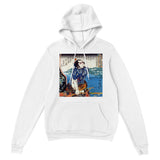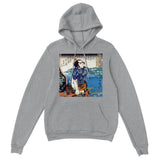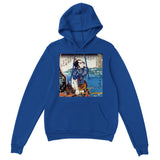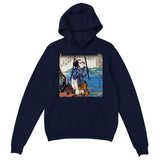'Kanchikotsuritsu Shuki' by Utagawa Kuniyoshi, ca. 1830. From the series 'The One Hundred and Eight Heroes of the Popular Suikoden'. This image is also available on:
Stickers
Tote Bags
T-Shirts
iPhone Cases
Samsung Phone Cases
Throw Pillows
The 'Shuihuzhuan', in Japanese the 'Suikoden' and known in English as the 'Water Margin', is a Chinese novel written in the 14th century by Shi Nai'an, and is considered one of the four great classics of pre-modern Chinese literature. To summarize it loosely, it's 'Robin Hood' meets 'War And Peace': a historical novel set against the turbulent backdrop of 12th century China, in which a group of bandits and rebels gather in the marshes of Liangshan to fight corrupt officials, before being caught up in an invasion from the north by the Liao. The novel includes many individual narratives, which often only intersect towards the end. Although fictional, many of the characters are real historical figures and the basic plot - a group of bandits leading a rebellion before reconciling with the government to fight the Liao - is based on real events. Historians are still unsure how much Shi Nai'an invented himself and how much he borrowed from existing folklore (or even if Shi Nai'an is the actual author, since there are indications that it could have been written, or at least heavily edited, in the 16th century).
Kuniyoshi was a promising pupil under the Utagawa school master Toyokuni, but for the first ten years of his career he struggled to break into the highly competitive ukiyo-e market in Edo (Tokyo). He managed to obtain a few commissions for portraits of beautiful women and experimented with textile patterns, but at one point he was forced to become a second-hand tatami mat salesman to make ends meet. Close to abandoning art altogether, in 1827 he scored his first major hit with a commission for individual portraits of all one hundred and eight heroes from the 'Water Margin', of which this is one. The series would be a runaway success and keep Kuniyoshi busy - and profitable - for years. This print depicts Zhu Gui (Kanchikotsuritsu Shuki in Japanese), whose nickname is the Dry Land Alligator. His role was operating an inn that served as a lookout for the bandits.
Kuniyoshi portrayed many of the characters in his One Hundred And Eight Heroes series with tattoos, which sparked the last great fashion for traditional Japanese tattoo art. In China tattooing was considered a somewhat barbaric art, only practised by the non-Han tribesmen of the empire, and criminals who were often tattooed with an indelible record of their crimes. As is so often the case, China's criminals and outcasts developed this mark of shame into a whole tradition of their own, and some of the bandits in the Water Margin are described as having full-body tattoos. The nine-tailed fox on Zhu Gui's back is a particularly striking example of Kuniyoshi's interpretation of this. Japan had a more mixed relationship with tattoos, and although they were still associated with criminality the fashion for them ebbed and flowed. Unfortunately, the sudden burst in popularity Kuniyoshi inadvertently caused may well have influenced the Meiji government to issue a tattoo ban in the 1860s; obsessed with all things Western, they wanted to rid Japan of anything that might make the Japanese seem primitive in European eyes, and tattooing also still carried the taint of criminality. Ironically, many Western visitors were as enchanted by it as by the rest of Japan's art and got tattoos while in Japan, including several members of the British royal family. But even today the stigma caused by the Meiji-era ban lingers in Japan, and tourists are advised to cover any tattoos - an attitude that's fading as younger generations rediscover their traditional heritage, but slowly.
Product Details:
Classic unisex pullover hoodie with pouch, printed on front, available in five different colors.
FREE SHIPPING
Average Delivery Time: 4 - 5 working days
Available colors: black, white, gray, blue, navy blue
- Air jet yarn gives softer feel and reduced pilling
- Double-lined hood with color-matched drawcord
- Tear away label
- Double-needle stitching at shoulder, armhole, neck, waistband and cuffs
- Pouch pocket
- 1 x 1 rib with spandex
- Quarter-turned to eliminate centre crease
Size guide
| S | M | L | XL | 2XL | 3XL | |
| A) Length (inches) | 27.17 | 27.95 | 29.13 | 29.92 | 31.10 | 31.89 |
| B) Half Chest (inches) | 20.08 | 22.05 | 24.02 | 25.98 | 27.95 | 29.92 |
| C) Sleeve Length (inches) | 23.82 | 24.21 | 25.00 | 25.39 | 25.79 | 26.18 |
| S | M | L | XL | 2XL | 3XL | |
| A) Length (cm) | 69.00 | 71.00 | 74.00 | 76.00 | 79.00 | 81.00 |
| B) Half Chest (cm) | 51.00 | 56.00 | 61.00 | 66.00 | 71.00 | 76.00 |
| C) Sleeve Length (cm) | 60.50 | 61.50 | 63.50 | 64.50 | 65.50 | 66.50 |
Care instructions
| Wash | Machine, warm, inside out, similar colors |
| Tumble Dry | Low |
| Bleach | Only non-chlorine |
| Dry Clean | Do not dry clean |
| Iron | Do not iron |










